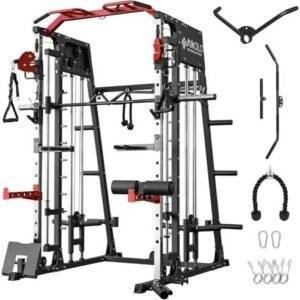Strength training is a fundamental aspect of fitness that can benefit people of all ages and abilities. Whether you want to build muscle, improve your overall health, or enhance your athletic performance, understanding the basics of strength training is essential. This guide is designed to help beginners navigate the world of strength training, covering everything from fundamental exercises to tips for creating an effective workout routine. By breaking down the process into simple steps, we aim to empower you to start your journey towards a stronger, healthier you. Let’s explore the key concepts and practices that will set you on the path to success.
Table of Contents
- Choosing the Right Equipment for Strength Training
- Understanding Basic Exercises and Techniques
- Creating a Balanced Workout Plan
- Nutrition Tips for Optimal Strength Gains
- Final Thoughts
Choosing the Right Equipment for Strength Training
When it comes to strength training, choosing the right equipment can significantly impact your progress and overall experience. Beginners often face a plethora of options, which can be overwhelming. To simplify the process, consider starting with essential pieces of equipment that promote versatility and ease of use. Some of the basics include:
- Dumbbells: Ideal for a wide range of exercises and allowing for gradual weight progression.
- Resistance Bands: Great for adding resistance to bodyweight exercises and are highly portable.
- Kettlebells: Perfect for dynamic movements that engage multiple muscle groups.
- Barbell Set: Essential for heavier lifts and foundational strength gains.
Alongside these, consider the space available and your personal fitness goals. If you’re aiming for overall strength and muscle development, a moderately equipped home gym can suffice. Analyze the options you might invest in further down the line, such as a weight bench or squat rack. To give you a better idea of equipment types and their benefits, check the following table:
| Equipment | Benefits |
|---|---|
| Dumbbells | Enhances muscle control and stability |
| Resistance Bands | Low-impact yet effective for joint health |
| Kettlebells | Improves grip strength and functional fitness |
| Barbell Set | Foundational for heavier compound movements |
Understanding Basic Exercises and Techniques
Strength training is built on a foundation of basic exercises that target multiple muscle groups. These fundamental movements can be categorized into a few core types:
- Push Exercises: These involve pushing weights away from your body, such as bench presses and shoulder presses.
- Pull Exercises: These include pulling weights toward your body, like rows and pull-ups.
- Leg Exercises: Squats and lunges fall into this category, focusing on your lower body strength.
- Core Exercises: Planks and Russian twists help build stability and strength in your core.
To effectively incorporate these exercises into your routine, focus on using proper technique. For example, maintain a neutral spine during squats to avoid injury, and ensure your feet are shoulder-width apart. It’s also beneficial to understand key principles such as the progressive overload, which involves gradually increasing the weight or resistance to continue making gains. Below is a simple table outlining the recommended sets and repetitions for beginners:
| Exercise Type | Sets | Repetitions |
|---|---|---|
| Push | 3 | 8-12 |
| Pull | 3 | 8-12 |
| Leg | 3 | 10-15 |
| Core | 3 | 10-20 |
Creating a Balanced Workout Plan
To build a strong foundation in strength training, it’s crucial to incorporate a variety of exercises that target different muscle groups. A balanced workout plan should consist of:
- Compound Exercises: Movements that engage multiple joints and muscle groups, such as squats, deadlifts, and bench presses.
- Isolation Exercises: Target specific muscles, like bicep curls and tricep extensions, to ensure all muscles are developed evenly.
- Aerobic Activities: Include cardio sessions such as running, cycling, or swimming to improve overall fitness.
- Flexibility and Recovery: Yoga or stretching routines to enhance flexibility and prevent injuries.
It’s also important to focus on your training frequency and set realistic goals. A beginner-friendly schedule might look like this:
| Day | Workout Focus |
|---|---|
| Monday | Upper Body Strength |
| Wednesday | Lower Body Strength |
| Friday | Cardio + Core |
| Saturday | Flexibility & Recovery |
This plan provides a well-rounded approach to strength training, ensuring all muscle groups are activated, while allowing ample time for recovery. Adjust the exercises and schedule as needed, and don’t forget to listen to your body to prevent overtraining.
Nutrition Tips for Optimal Strength Gains
To maximize strength gains, focusing on a balanced diet rich in macronutrients is essential. Your body needs an adequate intake of proteins, carbohydrates, and fats to support muscle recovery and growth. Aim for the following recommendations:
- Proteins: Include lean meats, fish, eggs, beans, and legumes to promote muscle repair. Aiming for about 1.2 to 2.2 grams of protein per kilogram of body weight is a good target.
- Carbohydrates: Choose complex carbs like whole grains, fruits, and vegetables as they provide sustained energy for workouts.
- Fats: Incorporate healthy fats from sources such as avocados, nuts, and olive oil to support overall health and hormone production.
Another vital aspect of nutrition for strength training is proper hydration. Staying hydrated helps maintain performance and supports recovery. Additionally, consider the timing of your meals around your workouts to enhance nutrient absorption and energy levels. Here’s a simple guide:
| Meal Timing | Recommended Foods |
|---|---|
| Pre-Workout | Complex carbs and protein (e.g., oats with Greek yogurt) |
| Post-Workout | Protein shake with a banana or a chicken wrap |
Final Thoughts
starting your strength training journey can be both exciting and rewarding. By following the basics outlined in this guide, you can build a solid foundation for your fitness routine. Remember to listen to your body, progress at your own pace, and most importantly, enjoy the process. With consistency and effort, you’ll not only improve your physical strength but also boost your overall well-being. Take the first step today, and embrace the benefits that strength training can bring to your life. Happy lifting!





